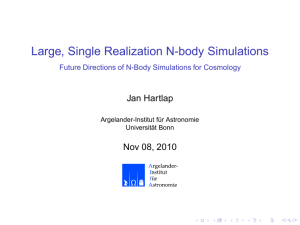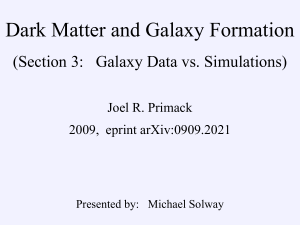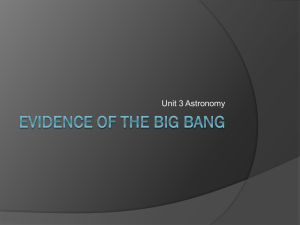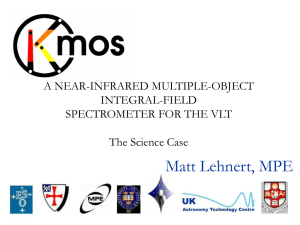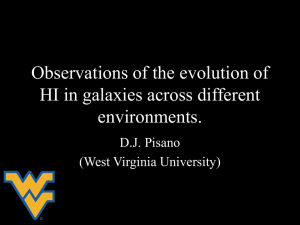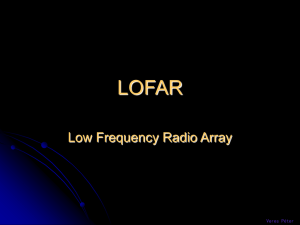Galaxy formation
advertisement
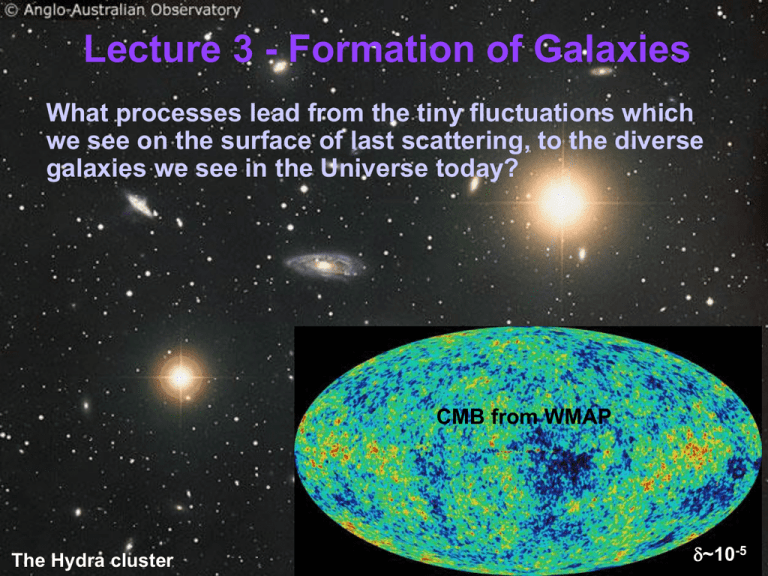
Lecture 3 - Formation of Galaxies What processes lead from the tiny fluctuations which we see on the surface of last scattering, to the diverse galaxies we see in the Universe today? CMB from WMAP The Hydra cluster ~10-5 Lecture 3 - Formation of Galaxies What processes lead from the tiny fluctuations which we see on the surface of last scattering, to the diverse galaxies we see in the Universe today? • Growth of structure in the expanding Universe • Collapse and virialization • Pressure and the Jeans mass • Baryon cooling • Models of galaxy formation • Some observational tests Cosmological simulations Redshift Cosmological simulations can trace the development of dark matter structures from primordial fluctuations in a given cosmology (here CDM). QuickTime™ and a YUV420 codec decompressor are needed to see this picture. 50 million particle N-body simulation 65 Mpc (comoving) z=9.00 65 Mpc z=4.00 50 million particle N-body simulation 65 Mpc z=2.33 50 million particle N-body simulation 65 Mpc z=1.00 50 million particle N-body simulation 65 Mpc z=0.00 50 million particle N-body simulation Evolution of Structure • Small fluctuations in the mass density are seen in the CMB fluctuations, at a level • In a static medium, such density fluctuations grow exponentially due to gravitational instability if they are not opposed by pressure forces. However, in an expanding medium it can be shown that the growth is linear: • Such density perturbations in the dark matter (which is pressureless, since d.m. particles interact only via gravity) grow until ~1, and the evolution becomes non-linear. Since density perturbations grow linearly, the first objects to go nonlinear (i.e. to reach ~1) will be those which had highest initial amplitudes. Whether this is high or low mass objects, is determined by the spectrum of initial fluctuations. In practice, cold dark matter models predict that will be largest for low mass objects. At high masses (corresponding to size scales ~1000 Mpc at z=0), the spectrum tends to a power law form M-2/3, whilst on smaller scales, the spectrum flattens due to the fact that even cold dark matter particles can move fast enough to blur out small scale fluctuations in the early Universe. log Evolution of Structure log M Evolution of Structure Non-linear density perturbations separate out from the Hubble flow when their mean density exceeds c - they then collapse and virialize. Evolution of radii of concentric shells near a spherical overdensity. Since E=K+V (k.e.+p.e.) is conserved during this collapse, r(t) and 2K=-V for a virialized system, it follows that Rv=Rmax/2. It can be shown that the radius within which the system is virialized (i.e. no net inward or outward particle motions) is that within which the mean density is ~200 c, often denoted R200. Rmax Rv t Hierarchical structure formation The result is of these processes is the development of structure through a process of hierarchical structure formation, as perturbations on progressively larger scales go non-linear, and smaller virialized masses find themselves incorporated into larger structures through repeated mergers. Ben Moore, Zurich QuickTime™ and a YUV420 codec decompressor are needed to see this picture. Response of the baryons - pressure The above applies to the dark matter, which dominates the mass however, the behaviour of the baryons is more complex: • Pressure forces will tend to prevent baryons from collapsing into overdensities with mass less than the Jeans Mass: • Before recombination, baryonic matter is supported by the high radiation pressure, and MJ>1016 M, so that the baryons do not collect in the developing dark matter potentials wells. • After recombination, radiation pressure no longer supports the baryons, MJ drops abruptly to ~ 106 M, and the baryons are able to collapse into galaxy-sizes structures. This accounts for why virialized (>>1) objects have been able to develop from such low amplitude (~10-5) baryon fluctuations since z~1000. Response of the baryons - cooling In addition to feeling the effect of pressure, baryonic material can also lose energy through radiation, which can have a profound effect on subsequent events. To investigate this, we need to know the temperature of the gas which collects in the forming cosmic structures. The virial theorem tells us that 2K=-V, where the kinetic energy of a system of mass M scales as K ~ NkT ~ MkT/m , where N is the total number of particles, of mean mass m. Since the gravitational potential energy scales as V ~ -GM2/R, it follows from the V.T. that T ~M/R. We have already seen that a virialised system (whatever its mass) has a mean density which is ~200 c, so that systems which virialize at a given epoch should have the same mean density, and hence M~R3. It follows that the characteristic virial temperature of a collapsed system scales with mass as T ~ M2/3 - i.e. massive systems are hotter. Response of the baryons - cooling In practice,the ability of gas to cool is a strong function of temperature, since at T>>105 K atoms are mostly ionized, reducing their ability to radiate. Though it may appear from the cooling function plot that gas at T>106K radiates more effectively, the cooling time =nkT/n2, is actually longer at high T, since the thermal energy per particle is higher. The result is that gas in halos with masses greater than about 1012 M is unable to cool effectively. This sets a natural upper limit to the mass of galaxies. In lower mass systems, gas is able to cool and form stars, whilst in more massive halos most of the baryons remain in the form of hot intergalactic gas. Cooling rate=n2 Cooling function for a cosmic abundance H+He mixture. Galaxy formation - two models Hierarchical galaxy formation The hierarchical assembly picture, whereby galaxies grow by mergers and gas cooling, is the most popular today. Direct simulations of galaxy formation Galaxy formation is very difficult to simulate, since it involves processes which take place over a very wide range of spatial scales. The following slides show one recent attempt to do this. Phase I: Formation of First Galactic Disks (1Gyr) • first relaxed small disks Matthias Steinmetz Direct simulations of galaxy formation Phase II: Bulge Formation and Disk Reassembly (2 Gyr) • disks are destroyed by merging, formation of an elliptical • later on: disk reassemble Matthias Steinmetz Direct simulations of galaxy formation Phase III: Well Developed Disk+Bulge Structure (3 Gyr) • slowly growing disk • young stars and gas in thin disk, bulge of old stars Matthias Steinmetz Direct simulations of galaxy formation Phase IV: Formation of a Giant Elliptical (7 Gyr) • nuclear star burst consumes nearly all remaining gas Matthias Steinmetz Models vs. observations Models of structure formation attempt to reproduce a variety of observed features of the Universe: • Fraction of cooled baryons ~10% - difficult • Spatial distribution of galaxies - OK • Luminosity function of galaxies - difficult at high L • Structure (e.g. disk size) and colours of galaxies problems with disk radii • Star formation history - OK? (obscuration problems) Many of the remaining problems arise from the difficulty in treating feedback - i.e. energy returned to the baryonic component by supernovae and AGN. Summary Dark Matter Virialized Halos (Hierarchical Growth) Intergalactic Medium Galaxies and Stars Observational constraints

